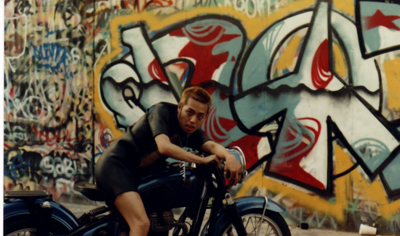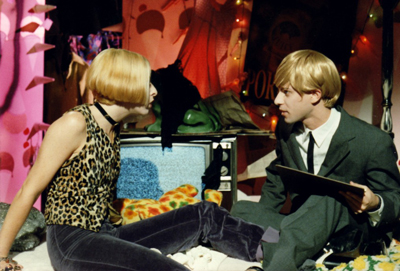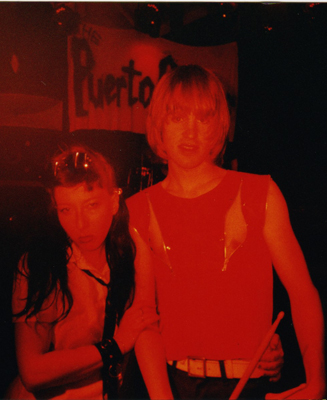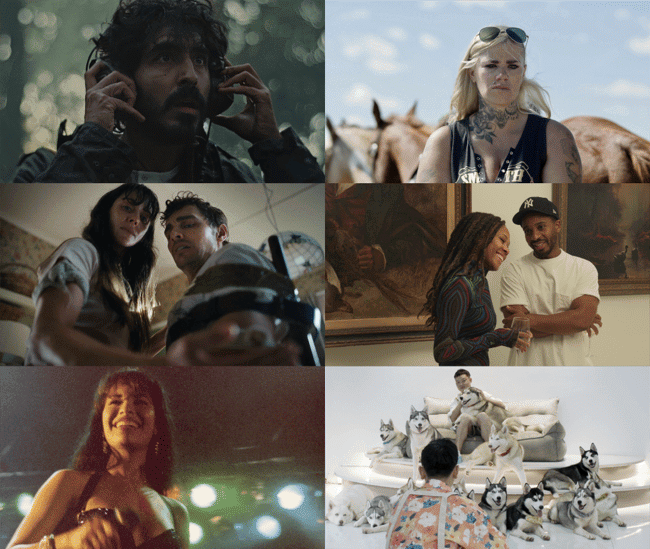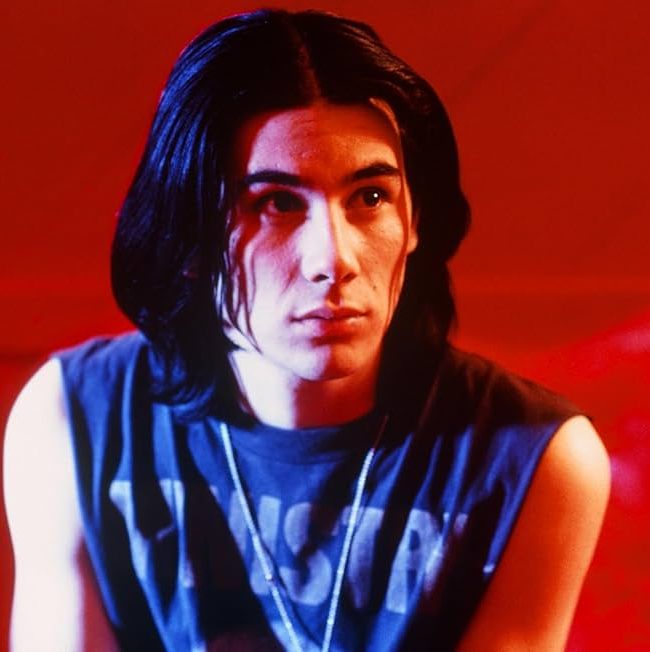A Conversation with Jon Moritsugu (PIG DEATH MACHINE)
(Two retrospectives of Jon Moritsugu’s films are launching simultaneously on Saturday, June 1, 2013—at the Spectacle Theater in Brooklyn and the Roxie Theater in San Francisco—along with an exclusive online run of his newest feature Pig Death Machine on Fandor. Visit the filmmaker’s official website to learn more.)
Combining the tropes of ’60s art-house with the primitive punk aesthetics of the Cinema of Transgression, Jon Moritsugu has been making movies far outside the mainstream for over 25 years. While his work has screened at prestigious festivals like Sundance, Berlin and Toronto, as well as on public television, he continually shirks convention and classification. Moritsugu’s world is overflowing with eye-popping production design, eardrum-destroying rock ‘n’ roll, gross-outs aplenty and deadpan one-liners you’ll be quoting for weeks. Like all true artists, he thrives under the limits of his budgets—producing an oeuvre of punk classics and establishing himself as DIY icon. On the cusp of a bi-coastal retrospective to celebrate the release of his latest film Pig Death Machine, I text-Skyped with Moritsugu about his crazy career.
Hammer to Nail: It seems like the punk aesthetic in indie/underground film really took off in the ’80s and ’90s. You were on the west coast for most of it. How aware were you of the Cinema of Transgression stuff when that started to pop up?
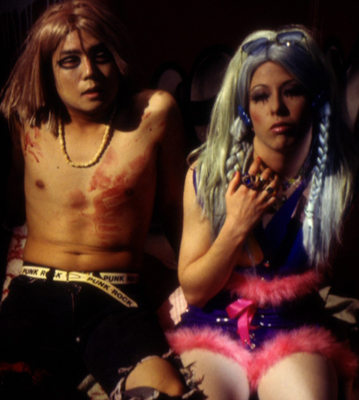 Jon Moritsugu: I started checking it out in the mid-’80s, at the suggestion of my Ivy League film professor, go figure… I got into the music and soundtracks, but not necessarily the “themes” or “concepts” behind a lot of these flicks. I totally wanted to make fun of the bloodletting, dildos, and corrosive confrontation, dude.
Jon Moritsugu: I started checking it out in the mid-’80s, at the suggestion of my Ivy League film professor, go figure… I got into the music and soundtracks, but not necessarily the “themes” or “concepts” behind a lot of these flicks. I totally wanted to make fun of the bloodletting, dildos, and corrosive confrontation, dude.
H2N: Totally, you have a lot more fun with it than they do.
JM: Yeah, I’ve always thought any type of art that is too serious or takes itself too seriously is a pretty boring.
H2N: A lot of movies from that time use camp and artifice in a very aggressive way, either in the script, or the production design, or the performances, or the editing. Or, in your case, all of those.
JM: I like the idea of creating another type of reality, a reality that doesn’t look like a cop show shot in HD or all the stuff in the street right outside your front door. Movies, to me, go back to an almost childlike and primal process where sets are built, costumes are made, lines are recited and everything is recorded… almost like putting on a play for the neighborhood. There is a definite connection to reality, but there is also an escape from reality. That, to me, is what makes a good movie.
H2N: Had you always wanted to make features?
JM: Yeah! I knew that I was gearing up for this ‘cause I looked at the shorts as being my “training ground.” My Degeneration was actually supposed to be another short, but a friend dared me to expand it into a feature… so I used virtually every shred of film I shot… reshot footage off of TVs to make it look different… the movie was pretty much a one-to-one shooting ratio, and I stretched it into 65 minutes.
H2N: What was that production like? How many days did you shoot for? How many people were working behind the camera? Most importantly, what did everyone eat for lunch?
JM: Oh shit, the crazy behind-the-scenes details! Okay, so I had gotten into a totally fucked up industrial accident in 1988, where my right arm was pulled into a conveyer built and scrunched! This happened a couple of days before I was to start shooting My Degeneration. So I went through tons of rehab and hospitals, and the next year I decided to restart the movie, almost as a form of physical therapy, you know, to prove to myself that I could still make movies.
Production was… can you say nano?! I made all the sets, shot it and did sound most of the time… it was pretty much me and the chick actors, who insisted we start everyday with whiskey, beer, and doughnuts. (I suppose they were all heavily throwing themselves into “the method,” since the movie is a tale of rock-n-roll debauchery and crash and burn). Lunch? No lunch. I tried to have everything done by noon to save money. We shot on weekends for a couple months, in Providence and a warehouse space I rented in badass Olneyville for $40! [NOTE: Jon was living in Providence, RI at the time.]
This was the first movie Amy Davis was in, and she was doing major flirting all the time, but I was too stupid to realize…. I just thought she was “turning it on” as an actor! [Davis is now his wife and the lead in all his movies except Hippy Porn.]
H2N: For a low budget movie, the title can be a great marketing tool. I remember seeing the boxes for Hippy Porn and Mod Fuck Explosion in the video store and being like “I’m definitely gonna rent this movie! Look at that title!”
JM: Yeah, I think the title is one third of the movie. It’s totally crucial, sort of like naming a band. Sometimes I have it before I even start writing the script, other times it comes at the end.
When we were shooting Mod Fuck, we used the working title Glitterlust. Do you know how hard it is to get free donations and meals when your flick is called Mod Fuck Explosion? We had to tone things down while in production. At the wrap party, I unveiled the actual and “new” title and people got freaked out. Everyone was like, “Awww, we liked Glitterlust better!”
H2N: Yeah, when I wrote my last movie, it was called The Ghost of Christ and we changed it before the Kickstarter for that exact reason.
JM: Yeah, right! No Jesus, no fucks, no controversy.
H2N: Do you have any titles in your head waiting for scripts? Would it be sacrilegious to share them before they find a home?
JM: Right now, I have none to spare, really. A few years ago, in a fever dream, I thought I came up with the best, most ultimate, hands down awesome movie title. LIFE! I totally thought this rocked. And the next morning, I was like, “What? That sucks.” So there will be no new movie called LIFE!
H2N: My Degeneration premiered at Sundance. What was that like? Did you just send it in and get a phone call one day?
JM: Yeah, that’s pretty much how it happened. I flew out not knowing what to expect and not knowing how to ski, but it was cool. This was 1990 so there were no cell phones, no indie bands, no deluxe swag bags. I think I got a bar of soap and a t-shirt from the fest. I was crashing in a condo with fest director Alberto Garcia and a bunch of other cinema misfits… drank way too much, stayed up ‘til dawn writing artist polemics, saw some completely underground movies. It was totally fun.
H2N: Did you meet Robert Redford?
JM: No, but I got an official festival certificate that he signed. I guess I can harvest some of his DNA from this… but I did wait in a payphone line (!!!) with Mario Van Peebles and we bonded on being “not white.”
H2N: How has the festival circuit changed? Chicago seems like its the last of the original ’80s underground fests that’s still around and championing really weird, innovative stuff…
JM: Yeah, I totally dig the Chicago Underground Film Fest. I dunno, from my point of view, it seems like the fests are looking for ultra-slick, totally polished stuff… the bigger fests especially looking for names attached to the projects… there are so many fests out there these days, but it does seem like everyone is a little tamer and more conservative, like they took too many chill pills. Even the ’90s seemed far more radical in terms of what was being programmed, especially in Europe.
Mod Fuck blew-up in Germany, Scandinavia, and the Benelux countries—they really responded to the angst, death, and Amy as a hot blonde walking on raw meat. Hippy Porn too, was a huge hit in France and played at a Parisian theater for over one year non-stop. We’re in the midst of planning a fall movie tour (the entire retrospective) with Low on High, our band, rockin’ live in France, Switzerland, Holland and the UK. Can’t wait to get back ‘cause I’m missing croissants and funny accents.
H2N: They definitely appreciate more outré stuff in Europe.
JM: One theory is that it’s a much older society that’s more in tune with historical perspective… a more sophisticated culture that can appreciate the “auteur theory” and the concept of a singular “artistic vision”… and people who drink like fish, take heavier drugs, and who just wanna watch the crazy shit.
H2N: So after Sundance you moved to California and made Hippy Porn. Was that production similar to My Degeneration?
JM: Nah, Hippy Porn was way more pro. I think it was a ten day shoot—five days with actual live sound and a pro recordist with a Nagra; the other five days MOS [no sound]. Jacques Boyreau lensed the whole movie. We shot on 16mm with rented gear. We actually got laughed out of the rental house—they thought we were fools and couldn’t shoot a feature under such meager conditions. We ate a lot of $3 burritos. These were really long days.
H2N: Did you tell them the movie was called Hippy Porn?
JM: Yeah, everyone knew that title. It was hard to get a print made because of the title—two or three labs bailed out on the project at the last moment.
H2N: What was the San Francisco film scene like then?
JM: Actually, the whole West Coast indie movie thing was just starting to happen. Los Angeles and San Francisco were the places to be. I had met Gregg Araki on the fest circuit. He and people like Roddy Bogawa were my compatriots—we all stayed in touch and tried to “fight the good fight.” You had producers like Jim Stark and Henry Rosenthal working their asses off, people like Allison Anders popping into prominence, there was a lot of energy in the scene. And SF was great—low rents, lots of places to get gear and edit your flick. Lots of freaks staying up all night on their “masterpiece.”
H2N: When did Amy move to San Fran?
JM: She moved out for Mod Fuck, so that was 1992.
H2N: And you became a couple during the shoot?
JM: Yeah, that’s why it’s my favorite movie… the memories (cue the smooth jazz please), the memories! We totally fell in love on the set and tried to keep it a secret… ha, everybody knew what was up, though.
H2N: That meat room is pretty memorable.
JM: Ha! “The meat garden” was a good movie set in Mod Fuck Explosion—actually one of my all-time faves. The art director, Jennifer Gentile, procured 800 lbs of “expired” raw meat that we installed in the garage of Henry Rosenthal, the producer (who was away for the weekend). Everyone was such a good sport dealing with the shit, especially Amy, who had to walk through it and act like it was a great-smelling garden. By the end of the shoot, it was really smelling awful and heating up because of decay. And getting rid of it was slightly problematic… I mean, where do you “dispose of” 800 lbs of raw meat? I thought the safest place (where we wouldn’t get into trouble) would be the back of a police station, in their dumpster. This worked out perfectly, two pick-up truck loads. Of course, the smell really lingered and when Henry returned from his trip, he was totally pissed at everyone. I don’t blame him. But it was really funny.
H2N: And did you write Kazumi in Mod Fuck and Katzumi and Marvin in Terminal USA knowing you would play those roles?
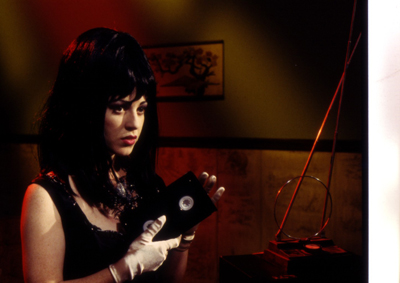 JM: Yeah. I was really into playing twins in Terminal USA ‘cause it’s such a dream role for an actor, and I wanted to totally piss off actors.
JM: Yeah. I was really into playing twins in Terminal USA ‘cause it’s such a dream role for an actor, and I wanted to totally piss off actors.
H2N: How did that project come together?
JM: There was a competition for public TV shows, and at the last minute I submitted my application. It was a total joke—I had one-word answers written in sharpie, shoe prints on my cover letter, and my five-page sample script was full of one-liner Asian put-downs. It turned out that it was the only application that made the committee laugh (out of the thousands they had to sift through), so I was one of 20 who got the go ahead and some major cash to write an actual script. That’s the one I completed in 42 hours… and it got the green light. So right after shooting Mod Fuck Explosion, I got $360,000 to shoot Terminal USA.
H2N: What was the budget for Mod Fuck Explosion?
JM: About $35,000.
H2N: $360,000 is still a wet dream for indie filmmakers today. What were the immediate pros and cons of that budget hike? Usually at least half of it disappears into salaries for all the extra people you have to hire…
JM: I thought a $360,000 movie was gonna be a lot easier to make than a $10,000 movie, but I was wrong! We had to deal with unions, insurance, payroll, salaries, limited work days, etc. and so much of the stuff that we could have gotten for free on a scumbag movie ended up costing us ’cause people knew we had the lucre. Plus we filmed in color 16mm with tons of Panavision gear, which was expensive and time consuming.
But of course, Terminal USA also premiered on television in hundreds of cities. That was a total boner.
It was actually an awesome experience. If I had to re-live it, there would be sooo many things I would do differently, like, buy brand new furniture! We had a cast/crew lounge area that we furnished with stuff we found on the street. And we paid the price ‘cause everybody got scabies from the skuzzy couches and lounge chairs! It was miserable. Amy and I had to check into a motel and live there ‘cause our apartment was way too scabies-ridden.
As far as being a writer/director, I learned that one must delegate responsibilities and then chill. I actually learned this about five years after the movie wrapped.
H2N: What was the editing process like on Mod Fuck? It came out a year after Terminal, and its pace is way beyond a normal narrative feature (even today).
JM: It was sort of weird, ‘cause I had a really rough cut version of Mod Fuck, then the money came in for Terminal USA. So I put Mod Fuck aside and spent seven months cranking out Terminal, then I went back to Mod. By this time I was totally freaked out on overwork and everything, so I ended up getting really loose and tight with the editing, paying less attention to narrative flow and storyline and putting more emphasis on sight, sound and spectacle. I wanted the movie to feel more like a live punk/hardcore show than a staged version of Shakespeare.
H2N: When did you start releasing the movies on video?
JM: From the very beginning. My first release was in the late ’80s and was Der Elvis with Mommy Mommy Where’s My Brain? I had very limited fundage so would do VHS deck-to-deck dubs in my apartment with a whole stack of Walgreens tapes, Kinko’s covers and labels, total DIY factory.
I was sending tons of copies out to magazines/publications for review purposes, and I was also getting them into video stores for rental and record stores for sale. I also was racking up the miles doing screenings anywhere that would have me—museums, theaters, clubs, pizza parlors, bars. I looked at the movies as “my band,” where I would try to book a tour and get them out to the public. And instead of selling records based on these live shows, I would sell VHS tapes.
H2N: When did you set up your website?
JM: Mid-’90s. The first version was all cartoon art, which definitely is not the best way to represent movies.
H2N: You hopped on the Fandor train pretty early, too.
JM: Fandor is great. I think things are still maturing and ripening and the audience has lots of room to grow. I totally dig visionary dude Walter Benjamin. And yo, as filmmakers, we’ve gotta embrace the technology and new modes of duplication/distribution to keep current.
H2N: There’s so much content out there now fighting for people’s attention.
JM: When I started out, I always looked at my movies in comparison to the mainstream blockbusters and spectacles… in the sense of, “It’s Saturday night, you can go see an action movie at the multiplex or a Moritsugu flick at the indie cinema or dive bar, or a Moritsugu film on DVD…” I always considered myself competing with all the big boys for an audience. And I still feel that way. Though my movies might be more, uh, “alternative” or “esoteric,” I’m still in the same entertainment three-ring circus on that Saturday night, trying to grab people’s attention and choose me over something else. And ultimately it comes down to entertainment. I wanna entertain the audience as much as Hollywood, albeit in a more original or subversive or perverse way.
H2N: How was the transition from film to video on Scumrock?
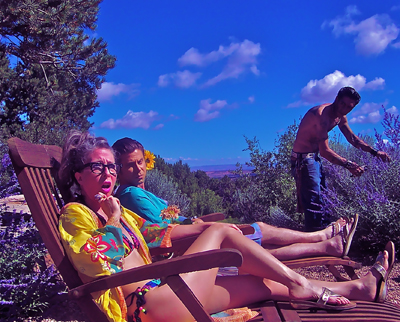 JM: Okay, the original plan was for Scumrock to be a $2 million, 35mm indie picture!!! I shit you not. I thought it was totally doable, what with the success of Fame Whore, which was up for Oscar consideration. This budget proved to be… ah, rather elusive, so we cut it down to $50,000. This was also a crack pipe dream, so Amy says to me, let’s shoot the movie on home video for real cheap! And alas, that is what we did—using a $150 camcorder (gift from mom) and resorting to scuzzy production principles. We shot Scumrock for $5,000 and in post, I really decimated the footage to get it looking really degenerated and scummy, but also beautiful. I wanted to drag video into the gutter and destroy any sheen or aura of a “pristine digital look.”
JM: Okay, the original plan was for Scumrock to be a $2 million, 35mm indie picture!!! I shit you not. I thought it was totally doable, what with the success of Fame Whore, which was up for Oscar consideration. This budget proved to be… ah, rather elusive, so we cut it down to $50,000. This was also a crack pipe dream, so Amy says to me, let’s shoot the movie on home video for real cheap! And alas, that is what we did—using a $150 camcorder (gift from mom) and resorting to scuzzy production principles. We shot Scumrock for $5,000 and in post, I really decimated the footage to get it looking really degenerated and scummy, but also beautiful. I wanted to drag video into the gutter and destroy any sheen or aura of a “pristine digital look.”
Pig Death Machine was completely different. New York director of photography extraordinaire (and also awesome filmmaker) Todd Verow joined us in New Mexico and shot the movie. Everything was shot on digital video and is tight, crisp and unscummy. And unlike Scumrock, which was edited on a VHS cuts-only system, Pig Death Machine was edited on Final Cut.
H2N: With raw meat animation!
JM: That took two days and was the final scene we shot. I was totally avoiding it and one afternoon, with our deadline looming, Amy made me go the supermarket (like a good producer) and buy everything we needed. That set the ball in motion for this finale/climax scene. It was all stop-motion animation, and it took hours to get the bacon to slither, the sausages to worm around, and the wall of hamburger to engulf the little ponies (OK, now I’m totally giving away the scene, but oh well…). We wanted it to be beautiful, repulsive, and funny, like life itself.
H2N: Has working digitally changed your aesthetic approach or production techniques drastically? And just to keep track, how many days did you shoot Pig Death Machine? How big was the crew? What did you guys eat for lunch?
JM: Digital is a lot cheaper, quicker, and lets you shoot more footage. I really have no problem with it at all. Plus, you don’t have to pay tons of money to film labs and wait three weeks for something as simple as a wipe to come back to you thru Fedex. Pig Death Machine production was really smooth—we shot for 12 days. We had a really small crew… Todd shooting everything, me directing and recording live sound onto DAT, Amy acting/producing/styling, some PAs and art people on the set, all the other actors, that’s about it. As far as food, whoa, the food was great. The New Mexico restaurant scene really supported us and almost every meal was a donated, sit-down situation (with full usage of menus). Of course, I always wanted to wrap by 5pm to spare the expense of feeding everyone dinner.
— Zach Clark







